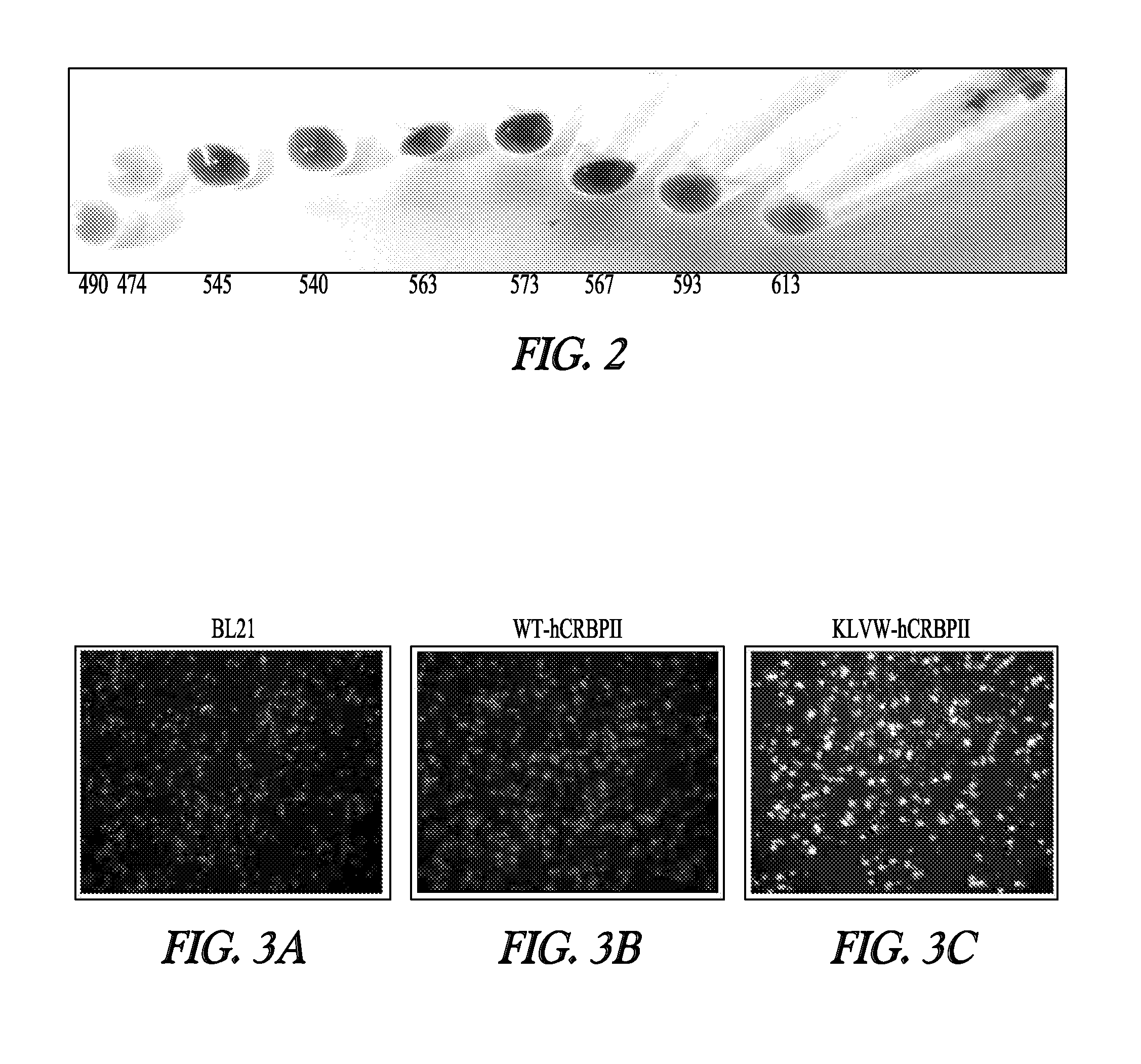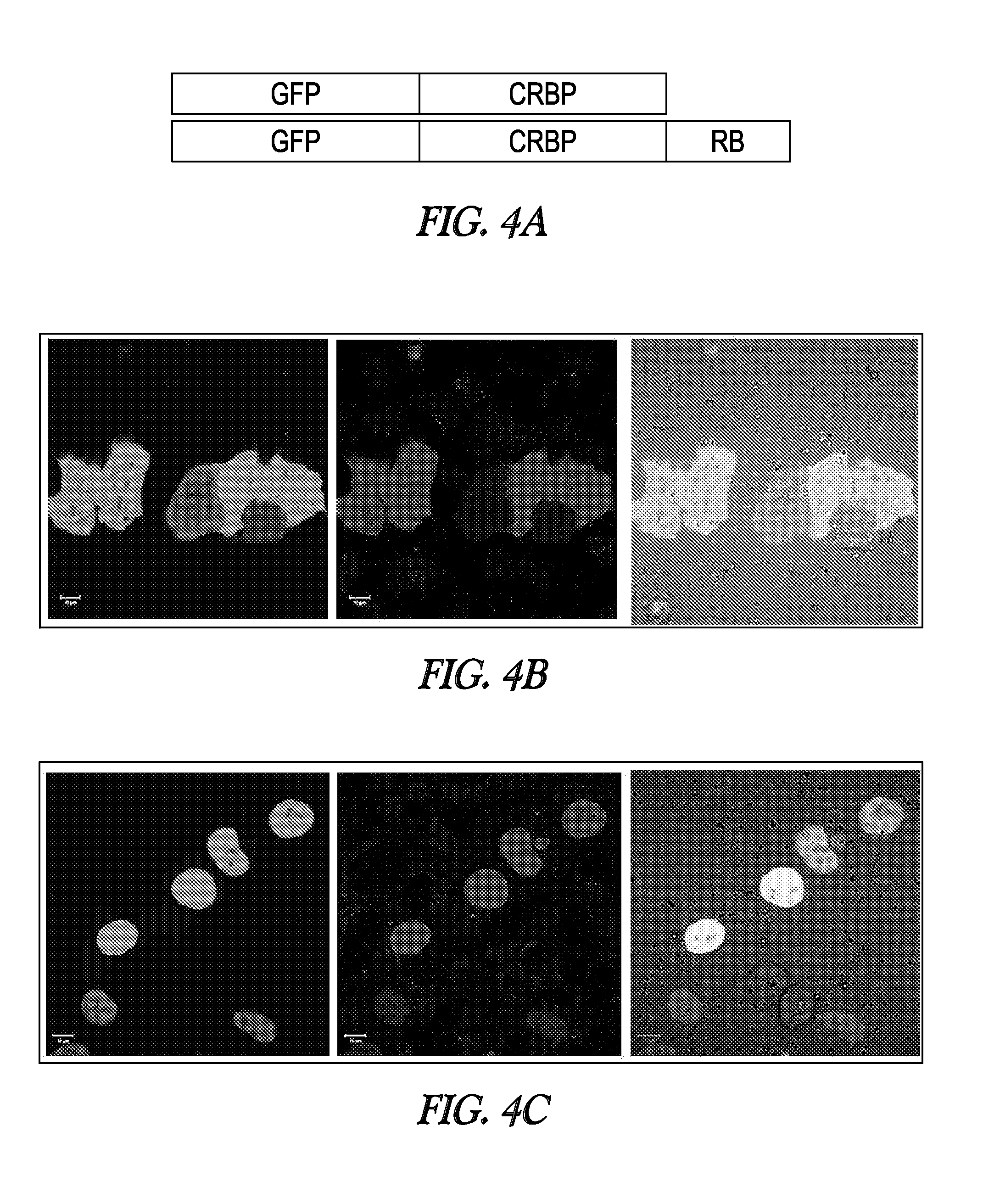Colorimetric and fluorescent proteins
a colorimetric and fluorescent protein technology, applied in the field of colorimetric and fluorescent proteins, can solve the problems of difficult observation of these molecules, difficult to ascertain the complex functions of biological molecules, locus of biomolecule activity and factors, etc., and achieve the effect of high affinity
- Summary
- Abstract
- Description
- Claims
- Application Information
AI Technical Summary
Benefits of technology
Problems solved by technology
Method used
Image
Examples
example 1
Materials and Methods
[0155]This Example describes some of the materials and methods used in developing the invention.
Generation of CRBP Mutant Polypeptides
[0156]CRBP mutants were made using “Quick Change” mutagenesis procedures, although no commercial kit was employed. A double-stranded DNA vector encoding a selected CRBP sequences was prepared, as well as two synthetic oligonucleotide primers containing the desired mutation. The ends of the oligonucleotide primers also contained DNA that was complementary to opposite strands of the vector. The CRBP-containing DNA vector was extended using the mutant primers and a thermally stable DNA polymerase (e.g., PfuTurbo® DNA polymerase) during polymerase chain reaction (PCR) thermal cycling. By incorporation of the oligonucleotide primers into the CRBP-containing DNA vector, a mutated plasmid containing staggered nicks was generated. After this primer-extension reaction, the product is treated with Dpn I endonuclease (target sequence: 5′-Gm6...
example 2
The Modified CRBP Polypeptides Transmit Light at a Variety of Wavelengths
[0161]This Example illustrates that modified CRBP polypeptides transmit light at a variety of wavelengths when combined with a retinoid or fluorescent dye ligand.
[0162]A variety of CRBP mutants were expressed in separate aliquots of E. coli host cells, and the mutant CRBP proteins were isolated by ion exchange chromatography. The CRBP protein preparations were suspended in phosphate buffered saline (PBS). Retinal at a molar ratio of about 1:2 was mixed with each mutant CRBP preparation and an ultraviolet-visible range spectrum of each CRBP:retinal complex was obtained.
[0163]As shown in FIG. 1A, mutations in the human CRBP gene give rise to polypeptide products that transmit light at different wavelengths when the mutant CRBP polypeptide is complexed with retinal (other dyes can also be used). For example, a modified human CRBPII polypeptide with lysine at position 108 instead of glutamine (i.e., a Q108K hCRBPII...
example 3
Modified CRBP Polypeptides Transmit Light and / or Fluoresce In Vivo
[0165]This Example illustrates that the signal provided by modified CRBP polypeptides is not masked by other polypeptides or factors in living cells and is sufficiently strong and distinct to be useful for in vivo studies.
[0166]A variety of CRBP mutants were expressed in E. coli cells. Retinal was then added to the separate cell preparations containing different CRBP mutant polypeptides to ascertain whether the cells expressing these polypeptides would strongly exhibit distinctive colors. As demonstrated by FIG. 2A, the proteins clearly and specifically color the cells, indicating that these proteins provide sufficient signal to be useful for detecting the expression of proteins in living cells. Moreover, the different modifications in the CRBP polypeptides give rise to light transmission in a variety of distinct colors. Thus, different modified CRBP proteins can be employed at the same time to observe different biolo...
PUM
| Property | Measurement | Unit |
|---|---|---|
| Fraction | aaaaa | aaaaa |
| Temperature | aaaaa | aaaaa |
| Temperature | aaaaa | aaaaa |
Abstract
Description
Claims
Application Information
 Login to View More
Login to View More - R&D
- Intellectual Property
- Life Sciences
- Materials
- Tech Scout
- Unparalleled Data Quality
- Higher Quality Content
- 60% Fewer Hallucinations
Browse by: Latest US Patents, China's latest patents, Technical Efficacy Thesaurus, Application Domain, Technology Topic, Popular Technical Reports.
© 2025 PatSnap. All rights reserved.Legal|Privacy policy|Modern Slavery Act Transparency Statement|Sitemap|About US| Contact US: help@patsnap.com



